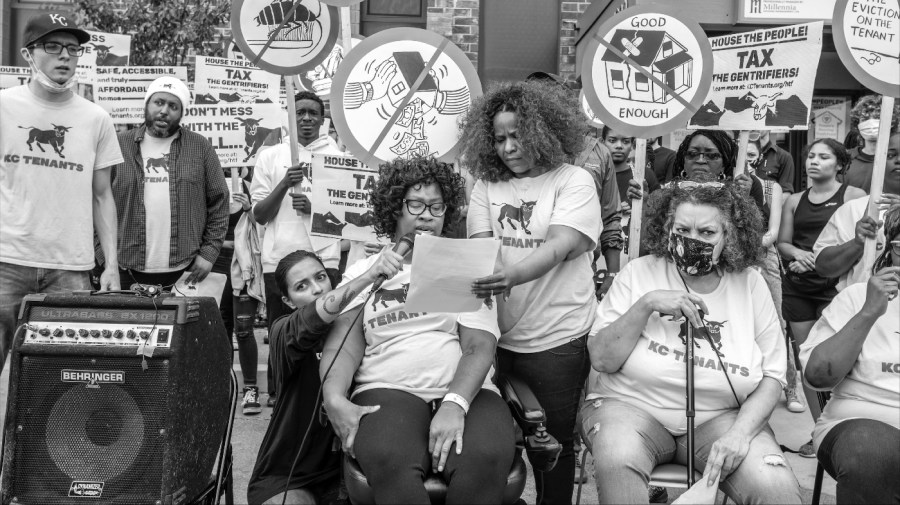As economic forces converge on the housing market amid the highest inflation in 40 years, one tenant rights activist is seizing a moment of opportunity to pursue fundamental changes in the way the U.S. approaches affordable housing.
Tara Raghuveer, founder of an influential tenants union in Kansas City and an organizer of a national tenant union federation, is working to capitalize on the social and financial pressures now squeezing the housing sector to produce what she sees as potential diamonds of public policy — effective rent caps for landlords who claim tax credits for building low-income housing units.
In April, the Department of Housing and Urban Development enacted what amount to 10 percent rent increase limitations for the federal program known as the low-income housing tax credit (LIHTC), in part a result of aggressive organizing from Raghuveer and her colleagues as well as from other tenant-focused advocacy organizations.
While the 10 percent cap is considerably higher than the 3 percent limit advocates had been seeking, Raghuveer regards the framework it establishes as a milestone among recent U.S. housing policy.
“It’s precedent-setting in that it’s the first time that we know of in recent history that the government has taken seriously the potential to condition federal financing on this type of protection,” she told The Hill in an interview.
Low-income housing advocates cheered the effective rent caps on, while organizations representing commercial builders and the real estate industry gritted their teeth at the change, saying it amounts to “[picking] winners and losers,” though they acknowledged it would likely “result in potentially smaller rent increases for some tenants.”
As the commercial groups recognize, the design of the cap is not traditional rent regulation but pegged to changes in national median income levels for a subset of LIHTC properties, conditions that make the cap “a little bit wonky,” in Raghuveer’s estimation, and difficult for tenants to identify.
But it’s just the beginning, Raghuveer says. She and her group, the national Tenant Union Federation, are looking beyond the $13 billion-a-year LIHTC program and toward the much larger government-sponsored mortgage backers Fannie Mae and Freddie Mac as places to expand tenant protections within housing finance providers that are already supported by the public.
Fannie Mae and Freddie Mac, which were nationalized in the form of public conservatorships in the wake of the 2008 financial crisis, issued more than $100 billion in mortgages in 2023 and more than $142 billion in 2022.
Accounting methods for these government-sponsored enterprises, which have been both public and private at various points in their history, vary among government agencies, and the Congressional Research Service even describes the final cost to U.S. taxpayers of supporting them as “unknown.”
However, the Congressional Budget Office puts the programs’ annual cost, which reflects the overall subsidy cost adjusted for market risks, at $6 billion, or about $64 billion through the next decade. That’s public money that should come with strings attached, Raghuveer believes.
“The government is actually in business with our landlords. Fannie and Freddie, even more than LIHTC, do $150 billion in business annually with our landlords. That’s $150 billion in financing that should come with conditions that protect tenants,” she said.
Housing issues are now at the forefront for many U.S. households, as shelter costs, which are particularly responsive to changes in monetary policy conditions, have skyrocketed following a rapid series of interest rate hikes by the Federal Reserve.
After displaying surprising strength throughout 2023, the U.S. economy is finally showing some signs of stress, with both first-quarter gross domestic product and the April jobs report falling shy of expectations.
Housing inflation, trailing the rise and fall in the consumer price index’s (CPI) headline number, has been coming down since last year, but it still remains elevated at a 5.7 percent annual increase. Mortgage rates are above 7 percent, near the highest levels in more than 20 years.
Meanwhile, rental prices have climbed 29.4 percent over the last four years, marking an average annual increase of 7 percent, according to a February report by real estate agency Zillow.
“At this point, the biggest driver of consumer price inflation is shelter costs,” former Federal Reserve economist Claudia Sahm told The Hill in a recent interview. “Housing is [about] 60 percent of CPI right now.”
Sensitive to housing pressures, Democratic lawmakers founded the Congressional Renters Caucus in 2023 and recently called for an expansion of the federal housing voucher program along with increased renter protections that include grants to help stave off evictions.
“Across the country our constituents are struggling to find and keep a home in an increasingly unaffordable rental housing market,” they wrote in a May letter to House appropriators.
Beyond the housing sector in particular, elevated prices in the economy and a resulting cost-of-living squeeze have had political consequences, especially as the social safety net set up by the federal government to address the pandemic has been dismantled and allowed to expire.
Concerted labor organizing in key sectors of the economy has led to some major contractual wins for big unions, including the United Auto Workers, which secured the reinstatement of cost-of-living adjustments after its latest strike in Detroit.
For Raghuveer, who thinks equally in terms of the individual lives of her constituents and the political dynamics of the various groups that represent them, the opportunities afforded to organizers by this high-pressure economic moment center on consolidation and concentration of disparate political interests.
“[When I started doing this], some people were organizing around public housing, some to repeal statewide bans on rent control, others around rights and protections at the local level, but it wasn’t adding up to much,” she said. “Eventually what became clear to me — and the clarity was quite uncomfortable — that the main thing that was missing was power, specifically power among people who are most impacted by the problem.”
“The status quo cannot continue,” she added. “Something’s got to give.”



